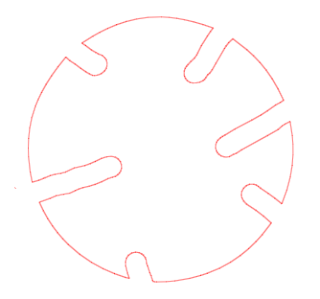First of all, Silhouette Studio is free. In fact, I downloaded and installed it before I got my Portrait, so I could start cutting immediately. Secondly, it's got Bézier curve editing functionality, like Adobe Illustrator. This means you can edit curves, or even create your own. So far, every design I've downloaded from the Silhouette online store can be edited. Even font characters can be converted to paths and edited.
I also like their other features that make designing easier, especially being able to resize/rotate shapes to percentages or even specific dimensions:
You're supposed to also be able to move them specific distances, but this feature wasn't working accurately for me.
You can specify certain lines to be cut and certain lines to be perforated (note: changing line style to dashed makes lines perforated, even if their cut style isn't).
Once you've finalised your design, you can maximise the number of copies to be cut from 1 page:
You can automatically trace designs - convert images to paths. I'm not sure what the settings do, though.
You can weld, subtract and do other modifications to shapes. But only weld worked as I expected it to, so far.
Problems
There IS one very very irritating thing, though. It is ridiculously insistent on everything being closed paths. It's somehow averse to open paths. For example, say you want to turn the circle on the left to the one on the right:It's trivial in Photoshop, right? (In fact that's how I made the image on the right) Let's see how to do it in Studio:
- Select the image
- Click Edit Points
- If the segment you want to delete isn't bound by 2 points, create 2 points binding it
- Click on one of the points binding it
- Click Break Path
- Try and move that point to see if it's the correct point you want to move
- If not, repeat steps 4-6
- If it's correct, click Delete Point
- It might be easier to just create a new point in the segment, break that, into 2, then delete both points
- Repeat for each segment you want to remove
Ok having a ridiculous number of steps for such a trivial and common operation is difficult enough. THIS is why I say it's averse to open paths. Seriously? What's the point of the eraser tool?
They must know this - the Designer edition has a proper eraser tool, in addition to this smearser. It's even listed as one of the features:
So they just want you to pay $50 for something that should have worked.
The other complaint is that the cutting profiles for different materials don't really work. It's impossible to tell if you're editing an existing profile or a nonexistent one, there are no save or load buttons, once you've got the settings right and click add, it deletes all your settings! They need to learn from Irfanview's JPEG save profiles or even World of Warcraft's equipment manager.
The store is difficult to use, because you can only search by date, and because it searches by OR, not AND (same as Google). It's worse than Apple's App Store, which tries to sort search results in a useful fashion, although not very well.
The important thing about a store is backing up. This is my hierarchy of backing up in programs:
- Apple's stores - you can redownload at any time, as many times as you want.
- Data is stored in individual, identifiable files with a publicised location (e.g. MS Office templates)
- Data can be backed up by copying entire folders. Prevents incremental backups and creating different versions of backups. (Music on Apple devices?)
- No backup (Pokemon on Game Boy Color?)







No comments:
Post a Comment